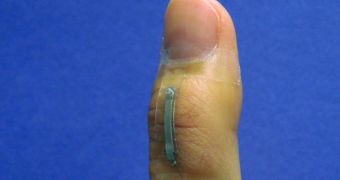Wearables are taking off, but a team of researchers from the North Carolina State University believe that the process can go faster and evolve more quickly, so they invented a new sensor that can work like a bandage.
We've already seen wearable gloves that let you hold phone calls through your hands (Call Me Gloves), vibrating gloves that help recovery from paralysis, clothing fabric that works as a battery, and even Bluetooth smart tech that can enable watches, bracelets, gloves, and hats in 2014.
What Dr. Yong Zhu and his team invented could be called the next logical step in the evolution of the wearable tech concept.
When we say bandage-like sensor, though, we don't mean that it is supposed to stem blood loss or keep a salve in place.
What we mean is that it conforms to your skin much like a bandage would. Better even, since it's pretty much transparent.
Granted, there is one, thin part that can be seen against the skin, but the rest can only be distinguished if you look closely.
Zhu invented the ultra-thin, flexible sensor from silver nanowires, a silicon plate, and liquid polymer. Not all that sophisticated really.
The nanowires were placed on the plate, after which the liquid polymer was poured over it and heated, turning from liquid to an elastic solid.
Then the whole thing was peeled off the silicon. The result was a pair of silver nanowire conductors held safely inside a flexible polymer strip.
It can be stretched 150% or more of its original length without harm, and it can bend as much as your joints and skin can.
The sensor can track pressure, human touch, bioelectric signals, strain, etc., because it can store and monitor electric charges (capacitance). All in all, they're much better than the capacitive sensors used by styluses and smart utensils, which are rigid and very specific in their use.
So far, Zhu and his team have tested the sensors by putting them on thumbs (controlling robotic devices) and knees (monitor walking, running, and jumping). Ultimately, they should be embedded in clothes and even skin.

 14 DAY TRIAL //
14 DAY TRIAL //